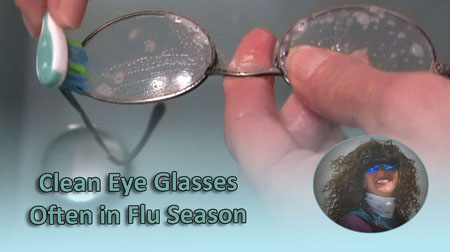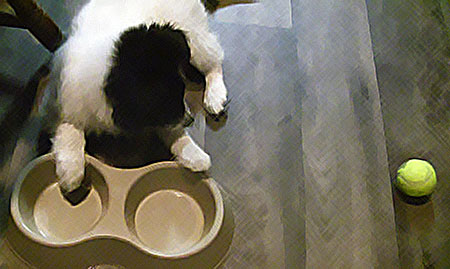
Blog & Long Form Content Writer
Portfolio
 |
 |
 |
| ONTHEGO.DOG By Marie-Louise | ONTHEGO.DOG By Marie-Louise | |
Clean your glasses more frequently during flu season. Your eye glasses rest on your nose and protect your eyes from anything in the air that could get into your eyes. We frequently need to touch and adjust our eye glasses, bringing them in direct contact with germs that our hands touch. So make a few minutes to clean your glasses every day during flu season. I use a very soft tooth brush. This is a baby toothbrush; it is very small and very soft. I wet the glasses, add a dab of antibacterial soap onto the brush bristles, then very gently brush the lenses and get into the nose pieces, temples and hinges. Do not use harsh chemicals or alcohol or dishwashing liquids on your eyeglasses or it may damage the finish and protective coatings that are on the lenses. I rinse my glasses in clean warm water, I shake off some of the water, then dab them dry with a tissue or microfiber cloth. Just a few other places I wipe over with disinfectant on a rag or wipes…. I wipe down the inside of my car EVERYTIME I come home after I drive somewhere during the pandemic. I fold the disinfectant wipe and run it through the keys on my keyboard. I wipe down the TV remote, and my keys & fob, and my cell phone. I know it sounds like a lot to do, but these are all things that I frequently touch during the day. If I stay home, I disinfect these items less frequently. I’m diligent to wipe everything down when I come home. It may seem like a lot to do, but it only takes a few minutes, to try and stay well, and keep your family well. Stay well everyone |
Tick Borne Disease Prevention Ticks are one of the most dreaded concerns of any outdoor enthusiast and pet owners alike. They are small, stealthy, and can have bitten into its host hours, even days before being discovered and removed. A single tick will latch onto more than one host in its lifecycle, and carries the diseases from previous victims to the next. The Center for Disease Control (CDC), lists more than fifteen known tick borne diseases in humans. Some diseases are only infectious to one type of animal, such as Swine Fever which only infects pigs and Canine Prioplasmosis, only infects dogs. How can we protect ourselves, our dogs and other pets from tick bites? Knowing the tick’s preferred habitat, careful inspection of yourself and your dog, and immediate removal and disposal of the parasite will help you to avoid contracting a bacterial infection or disease from a tick bite. We can learn to identify a tick habitat, even if we can’t always avoid them. When we’ve been out with our dogs, walking or trail running, mountain biking, or enjoying a BBQ in your yard, we need to think about giving ourselves a look over, and then our dogs, and maybe ourselves a second time before going back inside. When a tick does turn up, promptly remove it and dispose of it. A tick bite should be treated immediately with a topical antibiotic, rubbing alcohol, Neosporin, or Bactine. Knowing where to find ticks, gives us the option to avoid them, or change their environment to something less livable for them. There are two classes of ticks, hard ticks and soft ticks. Hard ticks nest and lay eggs in leaf litter. That is the tall grass, and brush at the edge of the road, the lawn, a park or anywhere along a wooded trail. Keeping your lawn mown short, and dispose of your clippings properly will make less welcoming environment for ticks. Soft ticks will lay eggs in small spaces, like a seam in your dog kennel. Clean and disinfect any areas thoroughly and regularly to destroy potential tick eggs from hatching. Unless we become hermits and avoid going outside ever, we are likely to find ourselves passing through locations that ticks are staking out looking for their next meal. Six legged ticks in the larvae stage are usually looking for a small host, like a rodent. Ticks aren’t selective and will latch onto whatever comes their way first. Look yourself over carefully and patiently. Make time to look over your dog, before you both go inside together. Keep a comb or brush handy for yourself and one for your dog, to help give a quick look through longer, fuller fur for anything that shouldn’t be there. I like the skinny little combs the school photographer used to give us on picture day, to comb through my dog’s fur. The comb is fine enough that it will catch a seed tick. When the parasite hasn’t bitten my dog, it will come out in the teeth of the comb. If the nasty bug has a hold of my dog, I leave the comb hung on the tick and pick up the tweezers. Removing the parasite as soon as is safely possible is very important. The sooner the bug is removed, the less chance it has of infecting your dog or yourself with bacteria or disease. Add tweezers to your pet travel bag, or your glove box, or keep near the door to your home. Whatever type of tweezers is most comfortable for you to use, then those are the best. I have a few different types of tweezers. My first choice is a pair of carpenter tweezers, bought at the hardware store. They are small, and the end is cut at nearly a 45 degree angle. These tweezers are meant to pull splinters out of calloused hands, and are good to get close to the skin and pull the tick straight out. My second thought if I need tweezers, are my sewing machine tweezers. They are long, and the tip is very narrow and pointy for threading needles. They have an angled bend near the tips, and good for getting into small places, but they are very pointy. I also have Clamp Pliers. They look like a surgical tool, and can be pressed closed and will stay closed, so you can concentrate on pulling straight, knowing the clamp is secure on the tick. It also stays holding on while you find a disposal method. No more “oops, I dropped it”. The life of a hard tick starts with eggs laid in tall grasses or leaf litter. The soft tick will lay her eggs in their hosts’ nest or burrow. The hatched six legged larvae latch onto a small animal host for a few days, and drops off to molt into the 8 legged nymph stage for 3 weeks. Looking like a small adult, the nymph finds and latches onto the next host to feed before releasing again, and becoming an adult. The adult tick finds a host to feed again before mating. Usually is bit in for24 hours. The female becomes engorged, the male doesn’t get as large, the male dies after mating and the female will lay between 2,000 and 18,000 eggs before she dies. There are many flea and tick treatment products. Some breeds of dogs have allergic reactions to some parasite treatments. It’s always best to refer to your pet’s veterinarian before selecting a product that would work best for your specific pet.
|
Pets on Vacation Like The Same Food While you make plans to travel with your pets, think about their foods, vitamins and medicines that you are feeding them. Plan ahead and know where you’ll find your pet’s food, and supplements at your destination. It’s best for your pet to have the same diet on vacation as he or she has at home. Some dogs can eat and digest anything; other pets need special diets, vitamins and medicines. Like other Border Collies, mine has a diet suggestion from her vet that has made a positive difference. Keeping their meals and schedule as consistent as possible will help keep them calmer. Traveling can be exciting and stressful for us and our pets. It may take some fun out of traveling with your pet if you’re in a B&B, hotel or a home of friends or family and you’ve switched pet food for the trip, and it isn’t agreeing with your dog. We recently traveled to Utah, and I couldn’t find the same dog food we have at home. WE had a personal emergency several times during the night, and we both went out for a 1:30 & 2:15 AM walks. I purchase pet food on-line and have it delivered at home. I planned to have her food sent to the address where we would be visiting, until I was told deliveries are unreliable there. We could NOT find the same food in the local stores, and settled on different brands that seemed to be of similar quality. When my dog didn’t eat, and was having tummy troubles, I didn’t know if it was the excitement of the travel or change of diet that made her insides queasy. When switching foods, it’s best to integrate the new brand to your pet slowly over a few days. I had brought some food from home, and we had to make a speedy switch, and it didn’t go smoothly. I still order my pet food on line, because it is very convenient for me. I switched to a General Mills brand of grain free dog food I can find in grocery stores, big discount stores, and pet supply stores around the country. Most of these stores will order on line and hold in store for pick up, so I know they can have our brand of dog food when we arrive.
|




